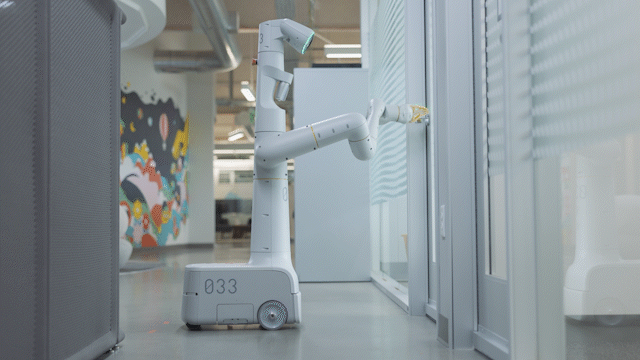Alphabet’s Moonshot Factory detailed a project to build “Everyday Robots” two years ago. Today it gave an update on how it has progressed towards building autonomous machines and real-world office testing.
The goal is to build robots that “can learn by themselves” rather than having to be precisely programmed “to solve just a single problem, in just one environment.”
Today, most robots still operate in environments specifically designed, structured, and even illuminated for them. The tasks they complete are very specific, and the robots are painstakingly coded to perform those tasks in exactly the right way, at exactly the right time. Yet this approach simply won’t work in the messy complex spaces of our everyday lives. Imagine trying to script all the possible ways to pick up a cup of coffee, anticipate the lighting or open a door. It simply wouldn’t scale.
Dropping the “project” from its name, the Alphabet X effort is now just called “Everyday Robots.” This comes as the effort is “moving out of the rapid prototyping environment of X to focus on expanding our pilots to some of Google’s Bay Area campuses.” Specifically:
We are now operating a fleet of more than 100 robot prototypes that are autonomously performing a range of useful tasks around our offices. The same robot that sorts trash can now be equipped with a squeegee to wipe tables and use the same gripper that grasps cups can learn to open doors.


These machines have a large wheeled base with a column sticking out. At the very top is a multi-camera array, while a spinner LIDAR sensor (with help from Waymo) is below to “take in the world around them.” The robots can transfer “learning from the virtual world to the real world.” For example, complex tasks (e.g., opening a door) can now be learned in a day with a higher success rate than five years ago when grasping objects “took the equivalent of four months.”
Using a combination of machine learning techniques like reinforcement learning, collaborative learning, and learning from demonstration, the robots have steadily gained a better understanding of the world around them and become more skilled at doing everyday tasks.
Halfway up is a robotic arm that has a multi-purpose “gripper” at the end. That particular attachment can grasp cups or other trash for sorting, as well as open doors (to see if a conference room needs to be cleaned or if it is missing chairs). A squeegee can also be attached to clean cafeteria tables.

The advancement Everyday Robots is particularly proud of is how it “can build on the algorithms and learnings from door opening and apply them to a new task: straightening up chairs in our cafes.”
This progress gives us hope that our moonshot for building general purpose learning robots might just be possible.
The Everyday Robots team imagines a future where machines work alongside humans to simplify everyday tasks. A longer-term goal is “enabling older people to maintain their independence for longer.” It differs from Alphabet’s industrial robot company called Intrinsic.
FTC: We use income earning auto affiliate links. More.

Check out 9to5Google on YouTube for more news:
Credit: Source link




















